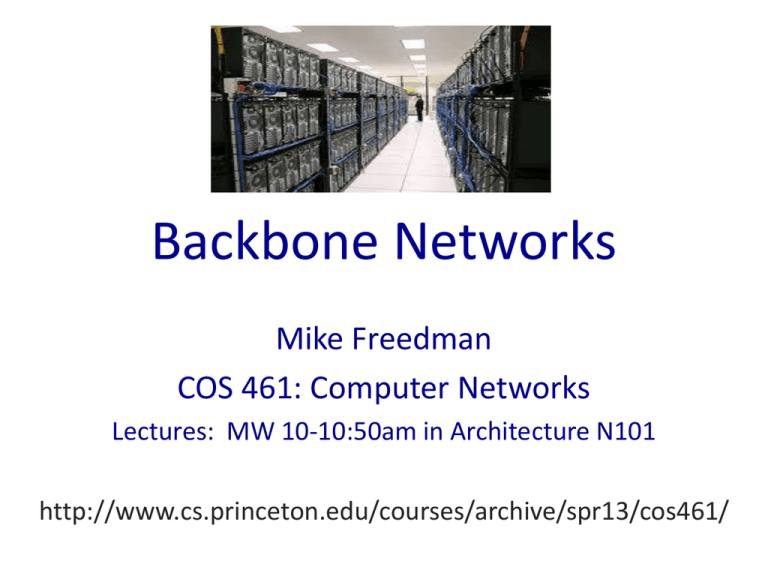Backbone Networks Mike Freedman COS 461: Computer Networks
advertisement

Backbone Networks Mike Freedman COS 461: Computer Networks Lectures: MW 10-10:50am in Architecture N101 http://www.cs.princeton.edu/courses/archive/spr13/cos461/ Networking Case Studies Datacenter Enterprise Backbone Cellular Wireless 2 Backbone Topology 3 Backbone Networks • Backbone networks – Multiple Points-of-Presence (PoPs) – Lots of communication between PoPs – Accommodate traffic demands and limit delay 4 Abilene Internet2 Backbone 5 Points-of-Presence (PoPs) • Inter-PoP links – Long distances – High bandwidth Inter-PoP Intra-PoP • Intra-PoP links – Short cables between racks or floors – Aggregated bandwidth Other networks • Links to other networks – Wide range of media and bandwidth 6 Where to Locate Nodes and Links • Placing Points-of-Presence (PoPs) – Large population of potential customers – Other providers or exchange points – Cost and availability of real-estate – Mostly in major metropolitan areas (“NFL cities”) • Placing links between PoPs – Already fiber in the ground – Needed to limit propagation delay – Needed to handle the traffic load 7 Peering Customer B Provider B • Exchange traffic between customers – Settlement-free • Diverse peering locations multiple peering points – Both coasts, and middle Provider A Customer A • Comparable capacity at all peering points – Can handle even load 8 Combining Intradomain and Interdomain Routing 9 Intradomain Routing A 4 3 F 5 9 D 3 8 10 8 E C B 4 G • Compute shortest paths between routers – Router C takes path C-F-A to router A • Using link-state routing protocols – E.g., OSPF, IS-IS 10 Interdomain Routing • Learn paths to remote destinations – AT&T learns two paths to Yale • Applies local policies to select a best route Sprint AT&T Tier-2 Tier-3 Yale 11 An AS is Not a Single Node • Multiple routers in an AS – Need to distribute BGP information within the AS – Internal BGP (iBGP) sessions between routers AS1 eBGP iBGP AS2 12 Internal BGP and Local Preference • Both routers prefer path through AS 100 • … even though right router learns external path AS 200 AS 100 AS 300 Local Pref = 100 AS 256 13 Local Pref = 90 I-BGP Hot-Potato (Early-Exit) Routing • Hot-potato routing – Each router selects the closest egress point – … based on the path cost in intradomain protocol • BGP decision process – Highest local preference – Shortest AS path A – Closest egress point 4 – Arbitrary tie break dst 3 F D 8 C 14 8 10 3 5 B 9 E 4 G Hot-Potato Routing Customer B • Selfish routing – Each provider dumps traffic on the other – As early as possible Provider B multiple peering points Early-exit routing Provider A • Asymmetric routing – Traffic does not flow on same path in both directions Customer A 15 Joining BGP and IGP Information • Border Gateway Protocol (BGP) – Announces reachability to external destinations – Maps a destination prefix to an egress point • 128.112.0.0/16 reached via 192.0.2.1 • Interior Gateway Protocol (IGP) – Used to compute paths within the AS – Maps an egress point to an outgoing link • 192.0.2.1 reached via 10.1.1.1 10.1.1.1 192.0.2.1 16 Joining BGP with IGP Information 128.112.0.0/16 Next Hop = 192.0.2.1 128.112.0.0/16 10.10.10.10 AS 7018 192.0.2.1 AS 88 IGP destination next hop 192.0.2.0/30 10.10.10.10 + BGP destination next hop 128.112.0.0/16 192.0.2.1 (A) True (B) False •The FIB of internal routers are of size O(all dest prefixes known to ISP) •The FIB of internal routers point to border router to neighbor ISP 17 Joining BGP with IGP Information 128.112.0.0/16 Next Hop = 192.0.2.1 128.112.0.0/16 10.10.10.10 AS 7018 192.0.2.1 AS 88 IGP destination next hop 192.0.2.0/30 10.10.10.10 + BGP destination next hop 128.112.0.0/16 192.0.2.1 Forwarding Table destination next hop 128.112.0.0/16 192.0.2.0/30 10.10.10.10 10.10.10.10 18 Interdomain Routing Policy 19 Selecting a Best Path • Routing Information Base – Store all BGP routes for each destination prefix – Withdrawal: remove the route entry – Announcement: update the route entry • BGP decision process – Highest local preference – Shortest AS path – Closest egress point – Arbitrary tie break 20 Import Policy: Local Preference • Favor one path over another – Override the influence of AS path length • Example: prefer customer over peer Local-pref = 90 Sprint AT&T Local-pref = 100 Tier-2 Tier-3 Yale 21 Import Policy: Filtering • Discard some route announcements – Detect configuration mistakes and attacks • Examples on session to a customer – Discard route if prefix not owned by the customer – Discard route with other large ISP in the AS path AT&T USLEC Princeton 128.112.0.0/16 22 Export Policy: Filtering • Discard some route announcements – Limit propagation of routing information • Examples – Don’t announce routes from one peer to another – Don’t announce routes for management hosts UUNET AT&T Princeton 128.112.0.0/16 Sprint network operator 23 Export Policy: Attribute Manipulation • Modify attributes of the active route – To influence the way other ASes behave • Example: AS prepending – Artificially inflate AS path length seen by others – Convince some ASes to send traffic another way AT&T 88 88 USLEC Sprint Princeton 128.112.0.0/16 88 24 Business Relationships • Common relationships – Customer-provider – Peer-peer – Backup, sibling, … • ISP terminology: – Tier-1 (~15 worldwide): No settlement or transit – Tier-2 ISPs: Widespread peering, still buy transit • Policies implementing in BGP, e.g., – Import: Ranking customer routes over peer routes – Export: Export only customer routes to peers and providers 25 BGP Policy Tier 1 ISPs? A. U, W B. U, X C. X, Y, Z Which path may packets take (given commercial policies)? A. B. C. D. Red Blue Green Orange 26 BGP Policy Configuration • Routing policy languages are vendor-specific – Not part of the BGP protocol specification – Different languages for Cisco, Juniper, etc. • Still, all languages have some key features – List of clauses matching on route attributes – … and discarding or modifying the matching routes • Configuration done by human operators – Implementing the policies of their AS – Business relationships, traffic engineering, security 27 Backbone Traffic Engineering 28 Routing With “Static” Link Weights • Routers flood information to learn topology – Determine “next hop” to reach other routers… – Compute shortest paths based on link weights • Link weights configured by network operator 2 3 2 29 1 1 1 3 5 4 3 Setting the Link Weights • How to set the weights – Inversely proportional to link capacity? – Proportional to propagation delay? – Network-wide optimization based on traffic? 2 3 2 30 1 1 3 1 3 5 4 3 Measure, Model, and Control Network-wide “what if” model Topology/ Configuration Offered traffic Changes to the network measure control Operational network 31 Limitations of Shortest-Path Routing • Sub-optimal traffic engineering – Restricted to paths expressible as link weights • Limited use of multiple paths – Only equal-cost multi-path, with even splitting • Disruptions when changing the link weights – Transient packet loss and delay, and out-of-order • Slow adaptation to congestion – Network-wide re-optimization and configuration • Overhead of the management system 32 Constrained Shortest Path First • Run a link-state routing protocol – Configurable link weights – Plus other metrics like available bandwidth • Constrained shortest-path computation – Prune unwanted links (e.g., not enough bw) – Compute shortest path on the remaining graph 33 s 5, bw=10 3, bw=80 d 5 bw=70 6, bw=60 Constrained Shortest Path First • Signal along the path s – Source router sends 3, bw=80 msg to pin path to dest – Revisit decisions periodically, in case better options exist 1 2 34 1: 7: 20 2: 7: 53 link 7 5, bw=10 d 5 bw=70 6, bw=60 20: 14: 78 53: 8: 42 link 14 link 8 Challenges for Backbone Networks 35 Challenges • Routing protocol scalability – Thousands of routers – Hundreds of thousands of address blocks • Fast failover – Slow convergence disrupts user performance – Backup paths for faster recovery – E.g., backup path around a failed link 36 Challenges • Router configuration – Adding customers, planned maintenance, traffic engineering, access control, … – Manual configuration is very error prone • Measurement – Measuring traffic, performance, routing, etc. – To detect attacks, outages, and anomalies – To drive traffic-engineering decisions 37 Challenges • Diagnosing performance problems – Incomplete control and visibility – Combining measurement data • Security – Defensive packet and route filtering – Detecting and blocking denial-of-service attacks – DNS security, detecting and blocking spam, etc. • New services – IPv6, IPTV, … 38 Conclusions • Backbone networks – Transit service for customers – Glue that holds the Internet together • Routing challenges – Interdomain routing policy – Intradomain traffic engineering 39




